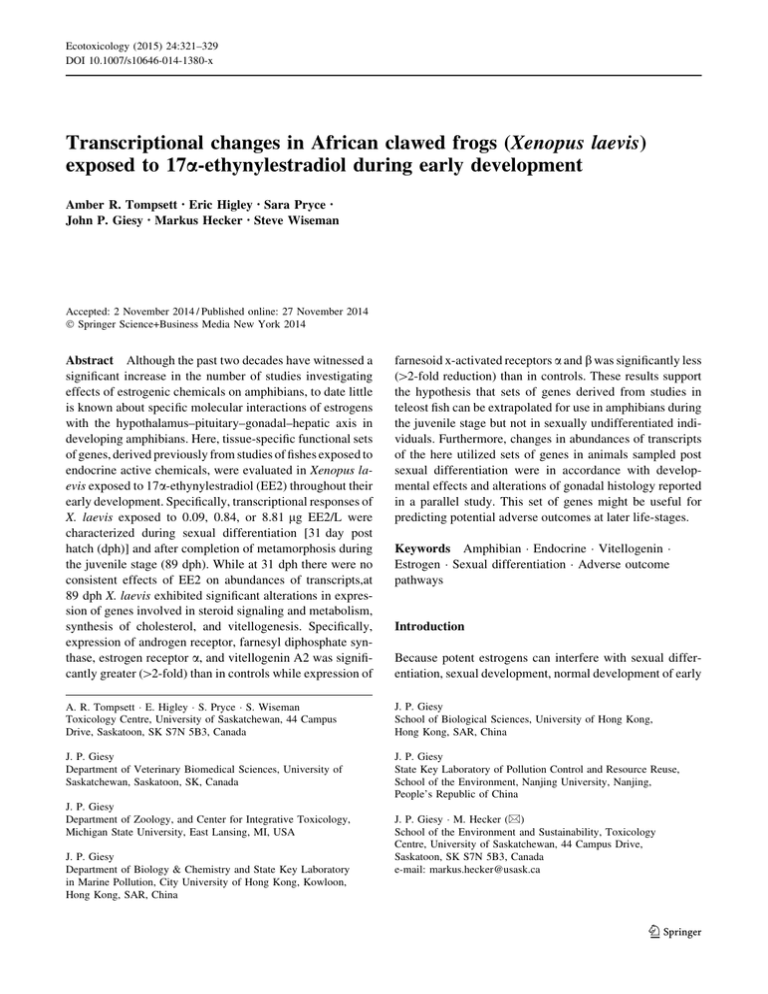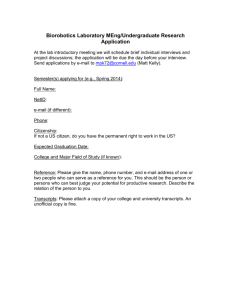
Ecotoxicology (2015) 24:321–329
DOI 10.1007/s10646-014-1380-x
Transcriptional changes in African clawed frogs (Xenopus laevis)
exposed to 17a-ethynylestradiol during early development
Amber R. Tompsett • Eric Higley • Sara Pryce •
John P. Giesy • Markus Hecker • Steve Wiseman
Accepted: 2 November 2014 / Published online: 27 November 2014
Ó Springer Science+Business Media New York 2014
Abstract Although the past two decades have witnessed a
significant increase in the number of studies investigating
effects of estrogenic chemicals on amphibians, to date little
is known about specific molecular interactions of estrogens
with the hypothalamus–pituitary–gonadal–hepatic axis in
developing amphibians. Here, tissue-specific functional sets
of genes, derived previously from studies of fishes exposed to
endocrine active chemicals, were evaluated in Xenopus laevis exposed to 17a-ethynylestradiol (EE2) throughout their
early development. Specifically, transcriptional responses of
X. laevis exposed to 0.09, 0.84, or 8.81 lg EE2/L were
characterized during sexual differentiation [31 day post
hatch (dph)] and after completion of metamorphosis during
the juvenile stage (89 dph). While at 31 dph there were no
consistent effects of EE2 on abundances of transcripts,at
89 dph X. laevis exhibited significant alterations in expression of genes involved in steroid signaling and metabolism,
synthesis of cholesterol, and vitellogenesis. Specifically,
expression of androgen receptor, farnesyl diphosphate synthase, estrogen receptor a, and vitellogenin A2 was significantly greater ([2-fold) than in controls while expression of
farnesoid x-activated receptors a and b was significantly less
([2-fold reduction) than in controls. These results support
the hypothesis that sets of genes derived from studies in
teleost fish can be extrapolated for use in amphibians during
the juvenile stage but not in sexually undifferentiated individuals. Furthermore, changes in abundances of transcripts
of the here utilized sets of genes in animals sampled post
sexual differentiation were in accordance with developmental effects and alterations of gonadal histology reported
in a parallel study. This set of genes might be useful for
predicting potential adverse outcomes at later life-stages.
A. R. Tompsett E. Higley S. Pryce S. Wiseman
Toxicology Centre, University of Saskatchewan, 44 Campus
Drive, Saskatoon, SK S7N 5B3, Canada
J. P. Giesy
School of Biological Sciences, University of Hong Kong,
Hong Kong, SAR, China
J. P. Giesy
Department of Veterinary Biomedical Sciences, University of
Saskatchewan, Saskatoon, SK, Canada
J. P. Giesy
State Key Laboratory of Pollution Control and Resource Reuse,
School of the Environment, Nanjing University, Nanjing,
People’s Republic of China
J. P. Giesy
Department of Zoology, and Center for Integrative Toxicology,
Michigan State University, East Lansing, MI, USA
J. P. Giesy
Department of Biology & Chemistry and State Key Laboratory
in Marine Pollution, City University of Hong Kong, Kowloon,
Hong Kong, SAR, China
Keywords Amphibian Endocrine Vitellogenin Estrogen Sexual differentiation Adverse outcome
pathways
Introduction
Because potent estrogens can interfere with sexual differentiation, sexual development, normal development of early
J. P. Giesy M. Hecker (&)
School of the Environment and Sustainability, Toxicology
Centre, University of Saskatchewan, 44 Campus Drive,
Saskatoon, SK S7N 5B3, Canada
e-mail: markus.hecker@usask.ca
123
322
life stages prior to metamorphosis, and homeostasis of the
endocrine system, they are among the most-studied endocrine-active substances (Chang and Witschi 1955; Witschi
et al. 1958; Hogan et al. 2008; Tompsett et al. 2012).
Estrogenic substances, such as 17b-estradiol (E2) and 17aethynylestradiol (EE2), enter the aquatic environment
through sources such as the discharge of liquid effluents from
wastewater treatment facilities (Ankley et al. 2007), urban
runoff (Jarošová et al. 2014) and runoff containing animal
manure (Hanselman et al. 2003). Estrogens are commonly
detected in the environment in the low nanogram per liter
range (reviewed by Corcoran et al. 2010), and biological
responses to these concentrations of estrogens in various
aquatic vertebrate species, including fish and frogs, have
been demonstrated (Jobling et al. 1998; Park and Kidd 2005;
Kidd et al. 2007; Pettersson and Berg 2007).
Amphibians such as the African clawed frog (Xenopus
laevis) are relatively sensitive to exposure to estrogens
throughout their ontogeny. During determination of sex, and
differentiation and development of gonads and secondary
sexual characteristics [between Nieukwoop-Faber (NF)
stages 50 and 54], exposure of X. laevis to potent estrogens
causes disordered sexual development and even reversal of
the male phenotype of genetic males to a female phenotype
(Chang and Witschi 1955; Villalpando and Merchant-Larios
1990; Miyata et al. 1999; Lutz et al. 2008; Tompsett et al.
2012). However, exposure of X. laevis to estrogens after the
period of sexual differentiation does not cause reversal of
phenotypic sex or alter development of gonads or secondary
sexual characteristics, but it can affect other biological
parameters. After sexual differentiation, the estrogen
receptor (ER) gene of X. laevis becomes auto-inducible (Tata
et al. 1993) and can be up-regulated by the presence of
endogenous and exogenous estrogens. Therefore, exposure
to estrogens after NF stage 62 has the potential to activate
genes and pathways that are responsive to estrogens.
Among vertebrates, effects of exposure to endocrine
active compounds, including estrogens, tend to be most
pronounced in organs that are part of the hypothalamic–
pituitary–gonadal–liver axis (HPGL) (Watanabe et al.
2009; Villeneuve et al. 2012). Recently, an extensive
graphical systems model of components of this axis in
teleost fish was constructed, which included derivation of
tissue-specific sets of genes affected by endocrine active
compounds (Villeneuve et al. 2012). These functional sets
of genes were derived from data from multiple experiments
with three different endocrine-active compounds, and it has
been shown that quantification of expression of these genes
is useful to predict tissue-specific responses to selected
EDCs. Because of some similarities of reproductive
endocrine systems between fish and amphibians, the set of
genes proposed by Villeneuve et al. (2012) are potentially
suitable to explore molecular toxicity pathways along the
123
A. R. Tompsett et al.
HPGL axis of amphibians exposed to endocrine-active
compounds, including estrogens.
The current study utilized chronic exposure of X. laevis to
the synthetic estrogen, 17a-ethynylestradiol (EE2), to determine effects on abundances of transcripts of estrogenresponsive genes during sexual differentiation (31 dph) and
after completion of metamorphosis (89 dph). X. laevis were
exposed to nominal doses of 0.1, 1, or 10 lg EE2/L from
before hatch through the larval and early post-metamorphic
period. Sexual differentiation and development of genetic
male individuals was affected, as has been described previously (Tompsett et al. 2012). Abundances of transcripts of 15
genes from the functional sets of genes that was proposed by
Villeneuve et al. (2012) as indicative of exposure of fishes to
estrogens, were quantified in X. laevis to determine whether
this set of genes would be indicative of endocrine disrupting
phenotypes in amphibians. The study also investigated whether developmental stage (time of sexual differentiation
[NF53] vs metamorphic climax [NF62]) had an influence on
patterns of response obtained for the selected set of genes.
Abundances of transcripts of ten genes involved in steroid
signaling and metabolism, two genes involved in cholesterol
biosynthesis, and three genes involved in vitellogenesis were
quantified (Table 1). Concentrations of EE2 were based upon
their ability to elicit effects on phenotype, but the least dose
was only 3-fold greater than the range of estrogen equivalents
(about 5–30 ng/L) that would be expected in a natural
watershed (reviewed by Kidd et al. 2007), but was 3-fold less
than the maximal concentrations of EE2 (about 0.3 lg/L)
detected in streams in the US (Kolpin et al. 2002a, 2002b).
Materials and methods
Experimental animals
Prior to commencement of research, approval for the use of
animals and all experimental procedures was obtained from
the University Committee on Animal Care and Supply
Animal Research Ethics Board at the University of Saskatchewan (Animal Use Protocol #20090066). Sexuallymature, adult X. laevis were purchased from Boreal Laboratories (St. Catharine’s, ON, Canada) and acclimated to
laboratory conditions [18 ± 2 °C water temperature; 12:12
light–dark cycle; fed Nasco frog brittle (medium nuggets)
(Salida, CA, USA) ad libitum daily] for 1 month. After
acclimation, pairs of X. laevis were spawned and eggs were
collected as described previously (Tompsett et al. 2012).
Exposure study design
The exposure was conducted as has been detailed previously (Tompsett et al. 2012). Briefly, each treatment group
Transcriptional changes in African clawed frogs
323
Table 1 Primer sets for quantification of expression of genes expected to be affected by exposure to estrogens
Gene identity
Abbreviation
Accession
number
Function
Forward primer
Reverse primer
Aryl hydrocarbon receptor 1a
ahr1a
AY635782.1
SSM
CATGGTGACTCCCCAGTCTT
GAGCTGCCATGACTGCATTA
Aryl hydrocarbon nuclear
translocator 1
arnt1
NM_001090153.1
SSM
CTCCTCCCAGAAGCACAAAG
AGCCTCTCGCTGTTCGATAA
Cytochrome P450 1a1
cyp1a1
NM_001097072.1
SSM
GATCCGAACCTGTGGAAAGA
CAATGGCTTCACCAACACAC
Estrogen sulfotransferase
est
NM_001095815.1
SSM
AATGCCAACGTGACACCATA
ATCAGCTGGATGGGAAGATG
Retinoid X receptor b
rxrb
BC108460.1
SSM
TAAGGGCTGGATGGAATGAG
GCCTGCACTGTGTGCACTAT
Pregnane X receptor
pxr
NM_001090137.1
SSM
GGTGTCTGCTGGTTGGTTTT
AGTTGTGGGGCTTGATTTTG
Glucocorticoid receptor
gr
NM_001088062.1
SSM
TGACATATCTGCCCAACCAA
CCAGGTCCCGTAGTAGGTCA
Farnesoid x-activated receptor a
fxra
NM_001088774.1
SSM
TGGAAGCACATCCACAAGAG
TAAGGGATCCCATGCTTCTG
Farnesoid x-activated receptor b
fxrb
NM_001090085.1
SSM
TGAAGGCTGCAAAGGTTTCT
CTGACACTTTCTGCGCATGT
Androgen receptor
ar
U67129.1
SSM
ATGCTTGTGTGCCAATACCA
TGCAACATGGATGAAGGAAA
7-dehydrocholesterol reductase
dhcr7
NM_001086117.1
CB
ATATTCCTGTTGGCGTTTGC
GCGCTTTGCCAGAGTATAGG
Farnesyl diphosphate synthase
fdps
NM_001096644.1
CB
CGACGATACGAGGAGGAGAG
GTATCCCAGCATGCCTCACT
Estrogen receptor a
era
NM_001089617.1
VTGS
CGACTGGCTCAGCTTCTTCT
AGGGGACAACATTCTTGCAC
High density lipoprotein binding
protein
hdlbp
NM_001086696.1
VGTS
CACAGGCTATGAGCGAAACA
TTCCGTACAGCTTTGCCTCT
Vitellogenin A2
vtga2
NM_001159281.1
VTGS
CTGACTCCTCCCCAAATTCA
CTGTACCAGGTGCTGCAAGA
Glyceraldehyde 3-phosphate
dehydrogenase
gapdh
NM_001087098.1
RF
CAGAGGTGCAGGTCAGAACA
GGAAAGCCATTCCGGTTATT
SSM steroid signaling and metabolism, VTGS vitellogenesis, CB cholesterol biosynthesis, RF reference
consisted of triplicate tanks. The appropriate nominal
concentration of EE2 was added to each tank in an ethanol
carrier, and the final concentration of ethanol in treatment
tanks was 0.0025 %. To validate that expected nominal
values were approximated, concentrations of EE2 in
exposure water were monitored periodically during the
exposure via high performance liquid chromatography
tandem mass spectrometry (HPLC–MS/MS) by use of
methods that have been described elsewhere (Chang et al.
2010; Tompsett et al. 2012). A 50 % static water renewal
was performed daily and basic water quality variables were
monitored daily (temperature, DO, pH, conductivity) or
weekly (nitrate nitrogen, nitrite nitrogen, ammonia nitrogen). Tadpoles and frogs were fed ad libitum daily with
Nasco frog brittle products.
Xenopus laevis were exposed to EE2 from before hatch
until 89 dph. At 31 dph, a subset of tadpoles that were
undergoing sexual differentiation was euthanized by an
overdose of MS-222 (Sigma, Oakville, ON, Canada). The
tail of each tadpole was frozen at -20 °C for use in an
assay to determine genetic sex (Yoshimoto et al. 2008), and
the body of the tadpole was flash frozen in liquid nitrogen
and stored at -80 °C for use in qPCR assays. At 89 dph,
the remaining X. laevis were euthanized. A tissue sample
from a leg of each froglet was frozen at -20 °C to use for
determination of genetic sex. The liver was removed from
each froglet, flash frozen in liquid nitrogen, and stored at
-80 °C for use in the qPCR assays. The gonadal
phenotype of each individual was determined as reported
previously (Tompsett et al. 2012).
Molecular analyses
At total of 20 tadpoles and 48 juveniles of X. laevis were
used for quantification of abundances of transcripts by use
of qPCR. Tadpoles were limited to genetic male individuals because effects of EE2 were expected to be most
pronounced in males. Juvenile frogs were assigned to one
of four groups based on genetic and phenotypic sex
(Tompsett et al. 2012): genetic and phenotypic female,
genetic and phenotypic male, genetic male and abnormal
phenotypic male, or genetic male and mixed sex
phenotype.
For quantitative polymerase chain reaction (qPCR), total
RNA was isolated from tadpoles of X. laevis by use of an
RNeasyÒ Plus Mini Kit (Qiagen, Mississauga, ON, Canada) and from samples of livers by use of an RNeasyÒ
Lipid Tissue Mini Kit (Qiagen) according to the protocol
provided by the manufacturer. Total RNA was quantified
and integrity determined, and cDNA was synthesized, as
previously described (Tompsett et al. 2013a). Primers for
use in qPCR were designed for genes of interest (Table 1)
based on published sequences for X. laevis mRNAs
(National Center for Biotechnology Information, http://
www.ncbi.nlm.nih.gov) by use of Primer3 software (Rozen
and Skaletsky 2000). Primers were designed to amplify
123
324
products of PCR between 100 and 150 base pairs in length
by use of standard parameters, and forward and reverse
DNA oligonucleotides (oligos) were purchased (Invitrogen,
Burlington, ON, Canada). For all primer sets, efficiency
curves were constructed and qPCR was performed as has
been described previously (Tompsett et al. 2013a). For
each target gene, abundance of transcripts was quantified
according to the Mean Normalized Expression (MNE)
method of Simon (2003) with glyceraldehyde 3-phosphate
dehydrogenase (gapdh) as a reference gene.
Statistical analysis
Statistical tests were performed by use of IBM SPSS 19
software (IBM, Armonk, NY). Treatment means are
expressed as mean ± S.E. throughout. Statistical significance was defined as p B 0.05. Data from qPCR assays
were first assessed for normality and homogeneity of
variances by use of Shapiro–Wilk and Levene’s tests,
respectively. Then, they were evaluated for statistical
equivalency between control and solvent control treatments
and pooled where appropriate (all cases in the current
study). Data were analyzed with ANOVA tests with post
hoc Tukey’s tests when the assumptions of normality and
equal variances were met. Data for transcripts that deviated
from normality and/or homogeneity of variances were
analyzed with nonparametric Kruskal–Wallis tests to
determine differences among treatments in abundances of
transcripts. Where the p value of the Kruskal–Wallis test
was significant, post hoc testing was performed by use
ofthe nonparametric, Mann–Whitney U tests to compare
each treatment group to the control group. Pearson correlation analysis was conducted to identify possible relationships between parameters in X. laevis exposed to
89 dph (no correlation analyses were conducted with tadpoles exposed until 31 dph as no significant differences
among treatment groups for any of the measured parameters occurred).
Results
Water quality parameters were all within an acceptable
range for culture of X. laevis over the course of the
experiment and have been reported previously (Tompsett
et al. 2012, 2013b). Validated concentrations of EE2 in
treatment tanks have also been reported previously
(Tompsett et al. 2012) and were 0.09 ± 0.005,
0.84 ± 0.06, and 8.81 ± 1.25 lg EE2/L immediately following water changes.
Exposure to EE2 for 31 dph did not affect abundances
of transcripts of several target genes. There were no significant differences in abundances of transcripts of aryl
123
A. R. Tompsett et al.
hydrocarbon receptor 1a (ahr1a), cytochrome P450 1a1
(cyp1a1), estrogen sulfotransferase (est), estrogen receptor
a (era), or farnesyl diphosphate synthase (fdps) in tadpoles
that were genetic males. The abundance of transcripts of
vitellogenin A2 (vtga2) was less than the method detection
limit. Since abundances of those six transcripts did not
change in X. laevis at this stage in development, quantification of abundances of remaining target transcripts was
not performed.
In contrast, exposure to EE2 for 89 d had a significant
effect on abundances of transcripts involved in steroid
signaling and metabolism. Abundances of transcripts of
farnesoid X-activated receptor a (fxra), farnesoid X-activated receptor b (fxrb), and androgen receptor (ar) were
significantly altered in livers from X. laevis exposed to EE2
(Kruskal–Wallis, p = 0.002, 0.006 and 0.014 for fxra, fxrb,
and ar, respectively). Abundances of transcripts of fxra
were -2.8-fold to -8.4-fold less in abnormal males, mixed
sex, and female individuals exposed to 0.84 lg EE2/L and
in abnormal males and females exposed to 8.81 lg EE2/L,
compared to the abundance in control individuals
(Table 2). For fxrb, changes in abundances of transcripts
ranged from -8.5-fold to -3.4-fold in abnormal male and
female individuals exposed to 0.84 lg EE2/L and female
individuals exposed to 8.81 lg EE2/L, relative to the
abundance in control individuals (Table 2). For ar, foldchanges in abundances of transcripts ranged from ?5.8fold to ?15-fold, in all individuals exposed to EE2, except
mixed sex individuals exposed to 8.8 lg EE2/L, relative to
control individuals (Table 2; Fig. 1). There were no
changes in abundances of transcripts of ahr1a, cyp1a1, aryl
hydrocarbon nuclear translocator 1 (arnt1), est, retinoid X
receptor b (rxrb), glucocorticoid receptor (gr), or pregnane
X receptor (pxr).
Abundances of transcripts of two genes involved in
synthesis of cholesterol, 7-dehydrocholesterol reductase
(dhcr7) and fdps, were evaluated in livers from individuals
exposed to EE2 until 89 dph. There was no change in
abundances of transcripts of dhcr7. There were significant
differences in abundances of transcripts of fdps among
treatments (Kruskal–Wallis, p = 0.013). Abundances of
transcripts of fdps were significantly greater by ?2.6-fold
to ?4.0-fold, in males, abnormal males, and females
exposed to 0.09 lg EE2/L and in abnormal males and
females exposed to 0.84 lg EE2/L, relative to control
individuals (Table 2).
Abundances of transcripts of genes involved in synthesis
of vitellogenin were significantly greater in livers from X.
laevis exposed to EE2 until 89 dph than abundances in
control individuals. Abundances of transcripts of era or
vtga2 were significantly different among treatments
(Kruskal–Wallis, p = 0.003 and 0.002 for era and vtga2,
respectively), but abundances of transcripts of high-density
SSM
VTGS
VTGS
CB
Ar
Era
vtga2
Fdps
M male, AM abnormal male, MS mixed sex, F female, SSM steroid signaling and metabolism, VTGS vitellogenesis, CB cholesterol biosynthesis
?2.8 (±0.4)
?2.9 (±0.8)
SSM
Fxrb
–, the fold-change was not significant
a
Data are presented for those transcripts that were significantly altered (Kruskal–Wallis, p B 0.05; post hoc Mann–Whitney U, p B 0.05; n = 3–6 frogs in each category) in individuals
exposed to EE2 compared to control individuals
–
?32 (±14)
–
–
?61 (±31)
?38 (±11)
?2.6 (±0.3)
–
?87 (±30)
?52 (±15)
?2.7 (±0.8)
?4.0 (±0.5)
?84 (±16)
?86 (±51)
?102 (±22)
–
?7.2 (±3.5)
?71 (±36)
–
?5.8 (±2.1)
–
–
?6.6 (±3.9)
?15 (±6.5)
?7.4 (±1.1)
?4.5 (±0.9)
–
?8.5 (±3.2)
?6.9 (±2.3)
?6.8 (±1.7)
?7.3 (±1.5)
?6.9 (±1.5)
?6.7 (±3.2)
?12 (±2.1)
?8.8 (±3.9)
-8.5 (±0.1)
?11 (±2.3)
?7.5 (±0.7)
–
–
–
-2.8 (±0.2)
-3.8 (±0.1)
-3.4 (±0.1)
–
-8.4 (±0.1)
–
–
–
–
–
–
SSM
Fxra
–
Biological function
Transcript
Fold-changea (±S.E.)
MS
AM
-3.9 (±0.1)
-3.4 (±0.1)
MS
AM
F
M
Phenotype
–
AM
F
8.81 lg/L
0.84 lg/L
0.09 lg/L
17a-ethynylestradiol concentration
Table 2 Summary of fold-changes in relative abundances of transcripts in livers from Xenopus laevis exposed to 17a-ethynylestradiol during development
MS
F
-8.1 (±0.1)
Transcriptional changes in African clawed frogs
325
lipoprotein binding protein (hdlbp) were not different in
livers from X. laevis exposed to EE2. For era, abundances
of transcripts were significantly greater by ?4.5-fold to
?12-fold, in all EE2 treatment groups, except mixed sex
individuals exposed to either 0.84 or 8.81 lg EE2/L, relative to control individuals (Table 2; Fig. 2). Abundances
of transcripts of vtga2 were ?32-fold to ?102-fold greater
in all EE2 treatment groups, except mixed sex individuals
exposed to 8.81 lg EE2/L, relative to control individuals
(Table 2; Fig. 3).
There were significant correlations between abundances
of transcripts of several pairs of genes as well as significant
correlations between abundances of several transcripts with
previously reported size of male (including normal and
abnormal males as well as mixed sex individuals) and
female froglets at metamorphosis, and with time to metamorphosis (Tompsett et al. 2012) (Table 3). In females,
there was a significant and positive correlation between
days to metamorphosis (DTM) and expression of ar
(r = 0.570; p = 0.014) and era (r = 0.512; p = 0.030),
and in males DTM was positively correlated with ar
(r = 0.445; p = 0.014) and vtga2 (r = 0.380; p = 0.039).
Furthermore, in females expression of the ar was positively
correlated with era (r = 0.789; p = 0.000), fdps
(r = 0.500; p = 0.035) and vtga2 (r = 0.703; p = 0.001),
and the era with fxra (r = 0.509; p = 0.031), fxrb
(r = 0.484; p = 0.042), fdps (r = 0.697; p = 0.001) and
vtga2 (r = 0.824; p = 0.000). Also, fxra and fxrb were
highly correlated in females (r = 0.980; p = 0.000). In
males, significant and positive correlations occurred
between the expression of ar and era (r = 0.692;
p = 0.000) and vtga2 (r = 0.654; p = 0.000). Expression
of era was positively correlated with vtga2 (r = 0.797;
p = 0.000), and fxra with fxrb (r = 0.792; p = 0.000).
When mixed sex frogs were excluded from the correlational analysis among males, the above effects were comparable with the exception that there was also a positive
correlation between fdps and ar (r = 0.451; p = 0.040)
and era (r = 0.472; p = 0.031).
Discussion
There were similarities between expressions of genes
observed in X. laevis exposed to EE2 and those that have
been reported to be modulated by estrogens in fishes.
Abundances of transcripts of genes involved with metabolism of steroids, synthesis of cholesterol, and vitellogenesis,
which have been linked to fecundity and feminization of
fishes, were detectable in livers of juvenile frogs after
89 days of constant exposure to EE2. These results suggest
that quantification of alterations in abundances of transcripts
previously identified in teleost fishes exposed to endocrine
123
326
Fig. 1 Fold-changes in abundances of transcripts of androgen
receptor (ar) in livers from Xenopus laevis chronically exposed to
17a-ethynylestradiol. Fold-changes are expressed as mean ± S.E.
There were significant differences in abundances of transcripts of ar
among treatments after exposure. Significant differences from control
treatments are denoted by different letters (Kruskal–Wallis,
p = 0.014; n = 3–6 frogs in each category)
Fig. 2 Fold-changes in abundances of transcripts of estrogen receptor
a (era) in livers from Xenopus laevis chronically exposed to 17aethynylestradiol. Fold-changes are expressed as mean ± S.E. There
were significant differences in abundances of transcripts of era among
treatments after exposure. Significant differences from control
treatments are denoted by different letters (Kruskal–Wallis,
p = 0.003; n = 3–6 frogs in each category)
active chemicals might also be suitable endpoints in subchronic and chronic studies of effects of environmental
estrogens on amphibians. However, there were differences
between the results of this study with X. laevis and those
reported for fishes. Abundances of transcripts of a number of
genes that were observed to be modulated in fishes, were not
123
A. R. Tompsett et al.
Fig. 3 Fold-changes in abundances of transcripts of vitellogenin A2
(vtga2) in livers from Xenopus laevis chronically exposed to 17aethynylestradiol. Fold-changes are expressed as mean ± S.E. There
were significant differences in abundances of transcripts of vtga2
among treatments after exposure. Significant differences from control
treatments are denoted by different letters (Kruskal–Wallis,
p = 0.002; n = 3–6 frogs in each category)
affected in tadpoles of X. laevis during the period of sexual
differentiation (31 dph), which indicates that the suitability
of the sets of genes identified in teleost fish might be limited
by developmental stage. It is likely that the lack of response
of some genes in tadpoles exposed to EE2 was linked to their
lack of auto-inducible ERs at this life stage (Tata et al. 1993),
which would limit their ability to respond to exogenous
estrogen via ER-mediated pathways.
Farnesoid X receptors (FXRs) are involved in transport
and metabolism of bile acid in vertebrates, and their natural
ligands are bile acids, which are end products of the
metabolism of cholesterol (Reschly et al. 2008). Nonmammalian vertebrates, such as fish, secrete metabolites of
steroids and xenobiotics into bile acids produced in the
liver during detoxification (Gibson et al. 2005). Similar
mechanisms are common to mammals, which also transcriptionally regulate some nuclear receptors, including
RXRs, PXRs, and FXRs, as a mechanism of hepato protection (Zollner and Trauner 2009; Henriquez-Hernandez
et al. 2007). In addition, lesser abundance of transcripts of
fxr in the human liver has been linked to the presence of
primary liver tumors (Martinez-Beccerra et al. MartinezBecerra et al. 2012). In the current study, abundances of
transcripts of both fxra and fxrb were significantly less in
some phenotype groups exposed to 0.84 and 8.81 lg EE2/
L compared to abundances in control groups. Lesser
abundances of transcripts of these receptors might indicate
that the hepatoprotective functions served by these receptors were affected.
Transcriptional changes in African clawed frogs
327
Table 3 Significant correlations between biological endpoints and abundances of transcripts in male and female Xenopus laevis exposed to EE2
Transcript
ar
Sex
Days to metamorphosis
era
fdps
vtga2
fxra
fxrb
–
Female
r = 0.570*
r = 0.789**
r = 0.500*
r = 0.703**
–
Male
r = 0.445*
r = 0.692**
r = 0.451*,a
r = 0.654**
–
–
Female
r = 0.512*
–
r = 0.697**
r = 0.824**
r = 0.509*
r = 0.484*
Male
–
–
r = 0.472*,a
r = 0.797**
–
–
fxra
Female
–
–
–
–
–
r = 0.980**
Male
–
–
–
–
–
r = 0.792**
vtga2
Male
r = 0.380*
–
–
–
–
–
era
–, the correlation was not significant
* Statistically significant correlation (p B 0.05)
** Statistically significant correlation (p B 0.01)
a
Mixed sex animals were excluded from analyses
The balance of estrogens and androgens is an important
part of endocrine homeostasis (Rivas et al. 2002). Although
the two classes of hormones have differing functions in
reproduction, formation of endogenous E2 is dependent
upon aromatization of testosterone (T) by the aromatase
enzyme (CYP19). Although E2 and T are ligands for the ER
and AR, respectively, there is evidence that the ER and AR
are not exclusively agonized by E2 and T, and there is the
potential for crosstalk between the two pathways (Eick and
Thornton 2011). For example, in the human prostate, 3badiol, a metabolite of dihydrotestosterone, is known to be an
agonist of ERb (Muthusamy et al. 2011). In the current study,
exposure to EE2, an agonist of the ER, resulted in greater
abundance of transcripts of ar in the liver. While this is not a
response that is typically associated with exposure to estrogens, the chronic nature of the exposure and the potential for
interactions between the AR- and ER-mediated pathways
could explain the effect. The endocrine system is regulated
by feedback loops, and it is possible that the greater abundance of transcripts of ar is an indication that frogs exposed
to EE2 were attempting to maintain homeostatic balance
between AR and ER signaling pathways via greater transcription of AR. This is also supported by the significant
correlation between the abundances of transcripts of ar and
era in froglets of both sexes.
Transcripts of fdps code for the enzyme that catalyzes
the formation of farnesyl diphosphate, a precursor of sterols, carotenoids, and ubiquinones, which is an intermediate
product in formation of cholesterol. In the current study,
the abundance of transcripts of fdps was significantly
greater in some groups of individuals exposed to 0.09 or
0.84 lg EE2/L. However, the abundance of transcripts of
dhcr7, which codes for the enzyme that catalyzes the final
step in the synthesis of cholesterol, was not affected by
exposure to EE2. In other non-mammalian vertebrates,
exposure to estrogens affects synthesis of cholesterol. In
female fathead minnows (Pimephales promelas) exposed
for 4–8 days to EE2 total cholesterol in the liver was significantly increased (Ekman et al. 2009). Concentrations of
cholesterol were also greater in livers of goldfish (Carassius auratus) exposed to E2 for 5 months (Sharpe and
MacLatchy 2007). In addition, X. laevis produced greater
amounts of fatty acids and cholesterol after exposure to
estrogen (Smith et al. 1978). In the current study, concentrations of cholesterol were not monitored, so it is
unclear whether synthesis of cholesterol was ultimately
affected by exposure to EE2, especially since those transcripts that encode enzymes involved in cholesterol
metabolism that were monitored displayed differential
responses to EE2.
Expression of both era and vtga2 are rapidly up-regulated in response to estrogens, even in genetic males. This
occurs via binding of an activated ER complex to an
estrogen response element (ERE) in the promoter region of
these genes (reviewed by Rotchell and Ostrander 2003). In
the current study, abundances of transcripts of era and
vtga2 were significantly greater in sexually immature or
male individuals exposed to EE2, even though these individuals do not normally express these genes. However, the
abundance of transcripts of hdlbp was not changed by
exposure to EE2. The lack of change in the abundance of
transcripts of hdlbp, which codes for a protein that binds to
and stabilizes vitellogenin, could be linked to the overexpression of vtga2 itself, which would render the stabilizing protein unnecessary.
Greater abundance of transcripts of vtga2 in the current
study complements the greater amount of vitellogenin
protein that was described previously for these same X.
laevis (Tompsett et al. 2012). Histological analysis of the
kidney-gonad complexes of these X. laevis revealed proteinaceous material in and around gonads and kidneys that
was identified, by use of immunohistochemistry, as vitellogenin. Thus, even though these frogs showed evidence of
vitellogenin protein deposits in the kidney-gonad complex,
123
328
abundances of vtga2 transcripts were still elevated, suggesting that disordered vitellogenesis was still occurring.
Furthermore, it was (Tompsett et al. 2013a) hypothesized
that the increased energy demand associated with the significant induction of vitellogenesis in both male and female
frogs exposed to EE2 resulted in a delay of metamorphosis.
This study reported a significant positive correlation
between the expression of vtga2 and DTM in male
X. laevis, which would support this hypothesis further.
The current study illustrated that quantification by use of
qPCR of the expression of sets of genes previously identified as being differentially expressed in teleost fishes
exposed to endocrine active chemicals was a useful point
of departure for detecting changes in estrogen-responsive
genes in X. laevis after long-term (89 dph) exposure to
EE2. For studies utilizing chemicals like EE2, this is
especially useful since environmentally realistic exposures
are likely to be chronic due to the constant input of
estrogens into the aquatic environment via sources such as
effluents from wastewater treatment plants and runoff from
agricultural operations. While the gene set quantified here,
which was chosen based on sets of genes derived from
exposures of teleost fishes to endocrine active chemicals
(Villeneuve et al. 2012), was found to be useful at the
89 days time-point, it was also determined that it was not
an effective tool for X. laevis that were 31 dph. Quantification of abundances of transcripts by next generation
sequencing technology, such as RNA seq, could be a viable
alternative for determining effects of exposure to estrogens
at this early life stage, or for the development of sets of
genes appropriate for determining effects of estrogens at
early life stages (Tompsett et al. 2013b).
Acknowledgments The authors wish to acknowledge the support by
the Natural Science and Engineering Research Council of Canada
(Discovery Grants), Grants from Western Economic Diversification
Canada (Project # 6578 and 6807), and an instrumentation Grant from
the Canada Foundation for Innovation to J. Giesy and M. Hecker.
J. Giesy and M. Hecker were supported by the Canada Research Chair
program. Furthermore, John Giesy was supported by Distinguished
visiting Professorship in the Department of Biology and Chemistry and
State Key Laboratory in Marine Pollution, City University of Hong
Kong, the 2012 ‘‘High Level Foreign Experts’’ (#GDW20123200120)
program, funded by the State Administration of Foreign Experts
Affairs, the P.R. China to Nanjing University and the Einstein Professor
Program of the Chinese Academy of Sciences. The authors would like
to thank J. Doering, S. Beitel, B. Tendler, and T. Tse for their assistance.
Conflict of interest The authors declare no conflict of interest in
context with the presented work.
References
Ankley G, Brooks B, Huggett D, Sumpter J (2007) Repeating history:
pharmaceuticals in the environment. Environ Sci Technol
41:8211–8217
123
A. R. Tompsett et al.
Chang C, Witschi E (1955) Breeding of sex-reversed males of
Xenopus laevis Daudin. Proc Soc Exper Biol Med 89:150–152
Chang H, Wan Y, Naile J, Zhang X, Wiseman S, Hecker M, Lam M,
Giesy J, Jones P (2010) Simultaneous quantification of multiple
classes of phenolic compounds in blood plasma by liquid
chromatography-electrospray tandem mass spectrometry. J Chromatogr A 1217:506–513
Corcoran J, Winter M, Tyler C (2010) Pharmaceuticals in the aquatic
environment: a critical review of the evidence for health effects
in fish. Crit Rev Toxicol 40:287–304
Eick G, Thornton J (2011) Evolution of steroid receptors from an estrogensensitive ancestral receptor. Mol Cell Endocrinol 334:31–38
Ekman D, Teng Q, Villeneuve D, Kahl M, Jensen K, Durhan E,
Ankley G, Collette T (2009) Profiling lipid metabolites yields
unique information on sex- and time-dependent responses of
fathead minnows (Pimephales promelas) exposed to 17 alphaethynylestradiol. Metabolomics 5:22–32
Gibson R, Smith M, Spary C, Tyler C, Hill E (2005) Mixtures of
estrogenic contaminants in bile of fish exposed to wastewater
treatment works effluents. Environ Sci Technol 39:2461–2471
Hanselman T, Graetz D, Wilkie A (2003) Manure-borne estrogens as
potential environmental contaminants: a review. Environ Sci
Technol 37:5471–5478
Henriquez-Hernandez L, Flores-Morales A, Santana-Farre R, Axelson
M, Nilsson P, Norstedt G, Fernandez-Perez L (2007) Role of
pituitary hormones on 17 alpha-ethinylestradiol-induced cholestasis in rat. J Pharm Exp Therap 320:695–705
Hogan N, Duarte P, Wade M, Lean D, Trudeau V (2008) Estrogenic
exposure affects metamorphosis and alters sex ratios in the
northern leopard frog (Rana pipiens): identifying critically
vulnerable periods of development. Gen Comp Endocrinol
156:515–523
Jarošová B, Erseková A, Hilscherová K, Loos R, Gawlik B, Giesy JP,
Bláha L (2014) Europe-wide monitoring of estrogenicity in
wastewater treatment plant effluents: the need for the effectbased monitoring. Environ Sci Pollut Res. doi:10.1007/s11356014-3056-8
Jobling S, Nolan M, Tyler C, Brighty G, Sumpter J (1998) Wide
spread sexual disruption in wild fish. Environ Sci Technol
32:2498–2506
Kidd K, Blanchfield P, Mills K, Palace V, Evans R, Lazorchak J,
Flick R (2007) Collapse of a fish population following exposure
to a synthetic estrogen. Proc Nat Acad Sci 104:8897–8901
Kolpin D, Furlong E, Meyer M, Thurman E, Zaugg S, Barber L,
Buxton H (2002a) Pharmaceuticals, hormones, and other organic
wastewater contaminants in US streams, 1999–2000. Environ
Sci Technol 36:1202–1211
Kolpin D, Furlong E, Meyer M, Thurman E, Zaugg S, Barber L,
Buxton H (2002b) Response to comment on ‘‘Pharmaceuticals,
hormones, and other organic wastewater contaminants in US
streams, 1999–2000: a national reconnaissance’’. Environ Sci
Technol 36:4007–4008
Lutz I, Kloas W, Springer T, Holden L, Wolf J, Krueger H, Hosmer A
(2008) Development, standardization, and refinement of procedures for evaluating effects of endocrine active compounds on
development and sexual differentiation of Xenopus laevis. Anal
Bioanal Chem 390:2031–2048
Martinez-Becerra P, Monte I, Romero M, Serrano M, Vaquero J,
Macias R, Del Rio A, Grane-Boladeras N, Jimenez F, SanMartin F, Pastor-Anglada M, Marin J (2012) Up-regulation of
FXR isoforms is not required for stimulation of the expression of
genes involved in the lack of response of colon cancer to
chemotherapy. Pharm Res 66:419–427
Miyata S, Koike S, Kubo T (1999) Hormonal sex reversal and the
genetic control of sex differentiation in Xenopus. Zool Sci
16:335–340
Transcriptional changes in African clawed frogs
Muthusamy S, Andersson S, Kim HJ, Butler R, Waage L, Bergerheim
U, Gustafsson JA (2011) Estrogen receptor beta and 17-betahydroxysteroid dehydrogenase type 6, a growth regulatory
pathway that is lost in prostate cancer. Poc Nat Acad Sci
108:20090–20094
Park B, Kidd K (2005) Effects of the synthetic estrogen ethinylestradiol on early life stages of mink frogs and green frogs in the
wild and in situ. Environ Toxicol Chem 24:2027–2036
Pettersson I, Berg C (2007) Environmentally relevant concentrations
of ethynylestradiol cause female-biased sex ratios in Xenopus
tropicalis and Rana temporaria. Environ Toxicol Chem
26:1005–1009
Reschly E, Ai N, Welsh W, Ekins S, Hagey L, Krasowski M (2008)
Ligand specificity and evolution of liver X receptors. J Steroid
Biochem Mol Biol 110:83–94
Rivas A, Fisher J, McKinnell C, Atanassova N, Sharpe R (2002)
Induction of reproductive tract developmental abnormalities in
the male rate by lowering androgen production or action in
combination with a low dose of diethylstilbestrol: evidence for
importance of the androgen-estrogen balance. Endocrinol
143:4797–4808
Rotchell J, Ostrander G (2003) Molecular markers of endocrine
disruption in aquatic organisms. J Toxicol Environ Health Part B
6:453–495
Rozen S, Skaletsky H (2000) Primer3 on the WWW for general users
and for biologist programmers. In: Krawetz S, Misener S (eds)
Bioinformatics methods and protocols: methods in molecular
biology. Humana Press, Totowa, pp 365–386
Sharpe R, MacLatchy D (2007) Lipid dynamics in goldfish (Carassius
auratus) during a period of gonadal recrudescence: effects of
beta-sitosterol and 17 beta-estradiol exposure. Comp Biochem
Physiol C 145:507–517
Simon P (2003) Q-Gene: processing quantitative real-time RT-PCR
data. Bioinformatics 19:1439–1440
Smith D, Penning T, Ansari A, Munday K, Akhtar M (1978)
Oestrogen-induced cholesterol and fatty acid biosynthesis in
Xenopus laevis liver during vitellogenic response. Biochem J
174:353–361
Tata J, Baker B, Machuca I, Rabelo E, Yamauchi K (1993)
Autoinduction of nuclear receptor genes and its significance.
J Steroid Biochem Mol Biol 46:105–119
329
Tompsett A, Wiseman S, Higley E, Pryce S, Chang H, Giesy J,
Hecker M (2012) Effects of 17-alpha-ethynylestradiol on sexual
differentiation and development of the African clawed frog
(Xenopus laevis). Com Biochem Physiol C 156:202–210
Tompsett A, Wiseman S, Higley E, Giesy J, Hecker M (2013a)
Effects of exposure to 17alpha-ethynylestradiol during larval
development on growth, sexual differentiation, and abundances
of transcripts in the liver of the wood frog (Lithobates
sylvaticus). Aquat Toxicol 126:42–51
Tompsett A, Wiseman S, Higley E, Giesy J, Hecker M (2013b)
Effects of exposure to 17alpha-ethynylestradiol during sexual
differentiation on the transcriptome of the African clawed frog
(Xenopus laevis). Environ Sci Technol 47:4822–4828
Villalpando I, Merchant-Larios H (1990) Determination of the
sensitive stages for gonadal sex-reversal in Xenopus laevis
tadpoles. Int J Develop Biol 34:281–285
Villeneuve D, Garcia-Reyero N, Martinovic-Weigelt D, Li Z,
Watanabe K, Orlando E, LaLone C, Edwards S, Burgoon L,
Denslow N, Perkins E, Ankley G (2012) A graphical systems
model and tissue-specific functional sets of genes to aid
transcriptomic analysis of chemical impacts on the female
teleost reproductive axis. Mut Res 746:151–162
Watanabe K, Li Z, Kroll K, Villeneuve D, Garcia-Reyero N, Orlando
E, Sepulveda M, Collette T, Ekman D, Ankley G, Denslow N
(2009) A computational model of the hypothalamic-pituitarygonadal axis in male fathead minnows exposed to 17alphaethinylestradiol and 17beta-estradiol. Toxicol Sci 109:180–192
Witschi E, Foote C, Chang C (1958) Modification of sex differentiation by steroid hormones in a tree frog (Pseudacris nigrita
triseriata Wied). Proc Soc Exp Biol Med 97:196–197
Yoshimoto S, Okada E, Umemoto H, Tamura K, Uno Y, NishidaUmehara C, Matsuda Y, Takamatsu N, Shiba T, Ito M (2008) A
W-linked DM-domain gene, DM-W, participates in primary
ovary development in Xenopus laevis. PNAS 105:2469–2474
Zollner G, Trauner M (2009) Nuclear receptors as therapeutic targets
in cholestatic liver diseases. Br J Pharmacol 156:7–27
123







